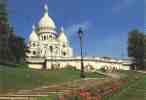![]()
The river valley of Paris is almost entirely circled by high ground. Upon the heights of Passy, on the Right Bank between the southern and western city limits and the Arch of Triumph, perch the beaux quartiers of the 16th arrondissement. The population contains a preponderance of persons with above-average incomes and, in many cases, of above-average pretensions.
The old-shoe amiability of Montparnasse (14th and a little of the 15th arrondissement) has been tainted by an injection of modishness provoked by the presence of the skyscraper and its attendant structures.
 The Butte-Montmartre (18th arrondissement) and the Buttes-Chaumont
(19th arrondissement), which rise among the northern rim of the
city, are still unaffectedly "popular" in the sense of "populi".
The oblong 18th arrondissement may perhaps be characterized as an
urban pudding full of ill-sorted lumps. The range runs from the
beautiful to the quaint, through the tawdry to the sordid.
It has many seductive village corners and even more brutal
city traps. It has broad avenues, but it also has winding lanes,
some of which transform themselves into five-flight stairways.
From the early 19th century until the 1920s' migration
to Montparnasse, it was the great art colony of Paris.
Some sections are mercilessly gewgawed for the tourist trade
and others are unselfconsciously picturesque.
It is the home of the hundreds of thousands of handworking,
ordinary folk and one of the main centres of crime and
prostitution. Montmartre itself is strewn with cheap
little nightclubs, which often prove to be menacingly
expensive.
The Butte-Montmartre (18th arrondissement) and the Buttes-Chaumont
(19th arrondissement), which rise among the northern rim of the
city, are still unaffectedly "popular" in the sense of "populi".
The oblong 18th arrondissement may perhaps be characterized as an
urban pudding full of ill-sorted lumps. The range runs from the
beautiful to the quaint, through the tawdry to the sordid.
It has many seductive village corners and even more brutal
city traps. It has broad avenues, but it also has winding lanes,
some of which transform themselves into five-flight stairways.
From the early 19th century until the 1920s' migration
to Montparnasse, it was the great art colony of Paris.
Some sections are mercilessly gewgawed for the tourist trade
and others are unselfconsciously picturesque.
It is the home of the hundreds of thousands of handworking,
ordinary folk and one of the main centres of crime and
prostitution. Montmartre itself is strewn with cheap
little nightclubs, which often prove to be menacingly
expensive.
 The most noted landmark of Montmartre, one of the most indelibly
Parisian, was inserted into the landscape only in 1919:
the Basilica of the Sacré Coeur (Sacred Heart), more fully,
of the National Vow to the Sacred Heart, paid for by
national subscription after the French defeat by the Prussians
in 1870. The work began in 1876 but was delayed by the death of
the architect, Paul Abadie, who took inspiration from the
12th-century five-domed Romanesque Church of Saint-Front
in Perigueux, itself inspired either by Venetian or Byzantine
churches. Alongside the monumental terraced stairway of
the garden-planted Square Willette below the church entrance
runs the only funicular railway in Paris.
The most noted landmark of Montmartre, one of the most indelibly
Parisian, was inserted into the landscape only in 1919:
the Basilica of the Sacré Coeur (Sacred Heart), more fully,
of the National Vow to the Sacred Heart, paid for by
national subscription after the French defeat by the Prussians
in 1870. The work began in 1876 but was delayed by the death of
the architect, Paul Abadie, who took inspiration from the
12th-century five-domed Romanesque Church of Saint-Front
in Perigueux, itself inspired either by Venetian or Byzantine
churches. Alongside the monumental terraced stairway of
the garden-planted Square Willette below the church entrance
runs the only funicular railway in Paris.
On the Buttes-Chaumont, just to the west of Montmartre, are the gasworks, the canal, the abbatoirs, and one of the most engaging parks in Paris. Called the Parc des Buttes-Chaumont, it was yet another Haussmann enterprise (1864-67). A bare hill, half hollowed out by abandoned tunnel quarries, stinking with the dumped refuse of generations, and the lair of army--especially Foreign Legion--deserters turned thug, it was turned into a romantic landscape with a lake, a waterfall, a grotto (false stalactites), winding woodland paths, and picturesque bridges. It is the largest park within the walls of Paris, 60 acres (25 hectares), and the only one to stay open as late as midnight.
This portion of the 19th arrondissement is known as Belleville, and just below on the slope towards the river is Ménilmontant, in the 20th arrondissement. Together, these two sections produce the Brooklynites or Cockneys of Paris, who have their own nasal, buzz-saw manner of speech and a hardheaded, warm-hearted approach of life. Part of their domain is Père-Lachaise Cemetery, site of the wall--le Mur des Fédérés--against which the last of the Communards fighters were shot, and to which pilgrimages are still made. Chopin, Marshall Ney, Baron Haussmann, Alfred de Musset, Balzac, Delacroix, Bizet, Rossini, Sarah Bernhard, Isadora Duncan and Colette are among the noted persons buried here.